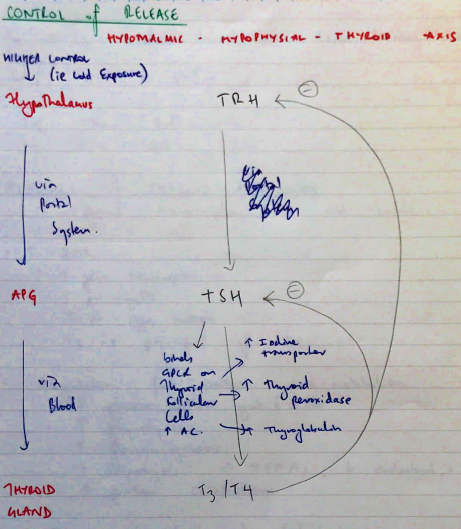U1v / 21B14 / 16A17: Describe the physiology of thyroid hormones
21B14: Exam Report
Describe the production, action and regulation of thyroid hormones
81% of candidates passed this question.
This question was divided in three sections to help candidates formulate an answer template, which for the most part was answered well. Most answers included a detailed description of the production and regulation of thyroid hormones, including the importance of negative feedback. A brief description of the action of thyroid hormones on intracellular receptors, and a system-based description of physiological effects, including CHO, protein and fat metabolism was expected.
16A17: Exam Report
Describe the physiology of the thyroid hormones.
40% of candidates passed this question.
Thyroid hormones consist of thyroxine (T4), tri-iodothyronine (T3) and reverse T3 (rT3). It was expected candidates would briefly describe each of these. T4 is a pro-hormone synthesized from tyrosine in follicular cells of the thyroid gland and represents 80% of body’s thyroid hormone production. It exists in free form, plasma protein bound (albumin and pre-albumin
(TBPA) and tissue protein bound thyroid-binding globulin (TBG) and has a half-life around 7 days. Tri-iodothyronine (T3) is the most biologically active thyroid hormone (5 times T4), is produced directly from tyrosine (20%) or in the periphery by conversion of T4 (80%) with a half-life 1.5 days. Reverse T3 (rT3) is formed via peripheral conversion of T4 by de-iodination.
A classic negative feedback loop exists to control thyroid hormone secretion. Thyroid Stimulating Hormone (TSH) from the anterior pituitary is controlled by Thyrotropin Releasing Hormone (TRH) from the Hypothalamus via hypothalamic-hypophyseal portal system. Both of these factors are inhibited by elevated levels of T4 and T3.
The mechanism of action is by binding to nuclear receptors to effect protein synthesis. Thyroid hormone has a wide variety of physiological effects across many systems including respiratory, cardiovascular, metabolic and growth and sexual function.
The answer required candidates to detail both the synthesis and control of thyroid hormones as well discussing the action of thyroid hormones. Few candidates could differentiate the roles and actions of T3 and T4.
U1v / 21B14 / 16A17: Describe the physiology of thyroid hormones
Definition
- Thyroid hormones are the 2 hormones produced & exported by thyroid gland:
- T3 – triiodothyramine (5%, 1.8nmol/L)
- T4 – thyroxine (95%, 103nmol/L)
- rT3 – reversed T3 = inactive, peripheral conversion of T4
Thyroid Anatomy
- Anterior to trachea
- Thyroid cartilage → 6th tracheal ring
- Shield shaped
- 2 lobes, joined by isthmus
- Arteries:
- Paired sup. thyroid arteries (1st branch external carotid)
- Thyroid arteries (subclavian a.)
- Venous
- Sup, middle, inf thyroid veins drain into L) BRACHIOCEPHALIC V.
Iodine Metabolism
- Ingested iodine → converted to iodide
- Absorbed in small intestine
- Then either:
- Taken up by thyroid
- Excreted in urine
- Iodide transported against [ ] & electrical gradients into thyroid follicular cells → ACTIVE TRANSPORT
- This transport stimulated by TSH
Synthesis & Storage
2. Iodine reacts with tyrosine residues on Thyroglobulin → produce MONO-IODOTYROSINE (MIT)
- Enzyme: THYROID PEROXIDASE
3. Further iodination → D1 – IODOTYROSINE (DIT)
4. Coupling
- MIT + DIT → T3
- DIT + DIT → T4
- All reaction enzyme: THYROID PEROXIDASE
- Thyroid hormones are stored in follicular colloid within Thyroglobulin molecule
Release
- Apical membrane → thyroid cells ingests colloid by ENDOCYTOSIS → vesicle formed
- In vesicle Thyroglobulin broken down by lysosome enzymes → releasing T3 + T4
- T3 + T4 diffuses through basolateral membrane to blood
↑TRH
When you need ↑metabolic rate (i.e. cold amino)
↓TSH
↑glucocorticoid levels
↑blood iodide
Metabolism
- T4 & T3 deoxidated in liver, kidney, skeletal m.
- 30% T4 → rT3
- T4 t½ 7d
- T3 t½ 1d
- 30% T4 → rT3
Actions of Thyroid Hormones
↑gene transcription in all cells
- ↑BMR
- ↑gene transcription
- ↑pr synthesis
- ↑ + size mitochondria
- T3 x 5 powerful cf. T4
- Regulation fat, protein, CHO metabolism
- ↑glucose uptake gut & cells
- ↑glycolysis
- ↑gluconeogenesis
- ↑lipolysis → ↑FFAs, ↓cholesterol, ↓TAGs
- ↑protein catabolism
- ↑Tissue sensitivity to catecholamines
- ↑HR, FoC, CO to meet demands
- Foetal development & childhood growth
- Promotes brain development
- Regulates bone growth
THYROID RECEPTOR = Nuclear receptor → regulates gene expression
Hyperthyroidism: excess thyroid hormone
Causes
- 99% – autoimmune diseases i.e. GRAVES → Ab bind & activate TSH receptors ∴uncontrolled TH production
- Pregnancy
- Iodine excess
- Lithium Tx
- Viral/bacterial infections
- Carcinoma
- Excess thyroid hormones (exogenous)
Clinical Features
- GENERAL: weight loss, malaise, fever, heat intolerance, proximal myopathy, gynaecomastia, goitre
- EYE: exophthalmos
- CARDIAC: palpitations, AF, ↑HR, cardiac failure
Hypothyroidism: insufficient levels of thyroid hormone
Causes
- Congenital
- Iodine def.
- Autoimmune → Hashimoto’s → Ab against Thyroid Peroxidase, thyroglobulin, TSH receptors → thyroid gradually destroyed
- Surgery
- Radioiodine Tx
- Excess iodine intake
Clinical Features
- GENERAL: lethargy, ↓reflexes, coarse skin + hair, ↑wt, constipation, hoarse voice, ↓temp, menorrhagia, myopathy, confusion, myxoedema coma
- CARDIAC: ↓HR, cardiomegaly, ↑cholesterol, IHD
Author: Krisoula Zahariou

